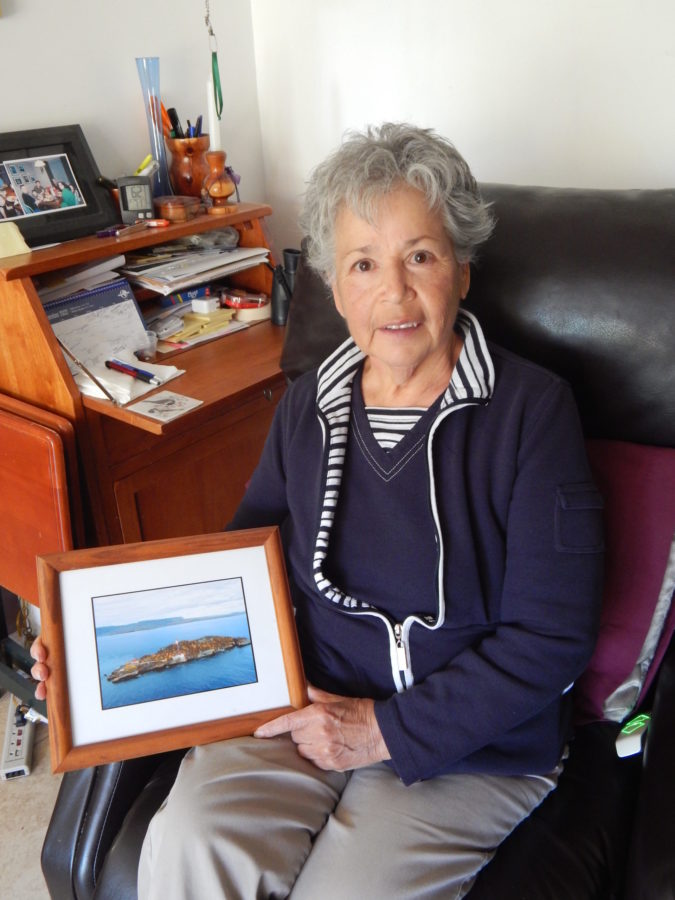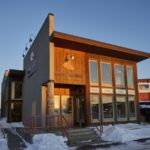Over a 21-year period, Eve Graham enjoyed some of the most spectacular views of Lake Superior in some of the lake’s remote places—and was paid for the privilege. Graham lived on three light stations—Angus Island, Trowbridge Island and Porphyry Island—and was assistant lighthouse keeper on the latter two. She retired only when all the stations were automated in 1989.
“The four stations around Thunder Bay were kept by couples, and the wives did the work as much as the husbands. We wives were unpaid help,” she remembers. “After some staff kept quitting from the loneliness, the Ministry of Transport finally figured it made sense to hire the wives as assistants. So, we were four women who were paid employees alongside our husband lighthouse keepers at this end of Lake Superior.”
Contrary to a popular notion, lighthouse staff did not work only at night and sleep in the day. A station typically maintained a 24-hour lookout, especially in stormy weather conditions, around flexible eight-hour shift schedules. Later, when 12-hour shifts were instituted, they were responsible only for the day shift. From the end of March to two weeks before Christmas every year for 21 years, Eve and her husband Gordon maintained light stations for the safety of Lake Superior shipping. The remoteness and relative lack of access to the station islands brought special challenges to the families.
“I called Angus Island ‘Alcatraz’ because it was so difficult to get in and out of there,” Eve says. “It was barely large enough to have the lighthouse, the fog alarm building, the boathouse and the keeper’s houses on it. Gordon loved the isolation, but after about four months, I didn’t. I loved having people to talk to, so when we could have visitors, which was rare, I would invite them in for coffee and cinnamon buns that I’d baked myself.”
The weather and isolation also meant that supplies had to be bought in bulk and brought in by Coast Guard boats, or station boats when the weather allowed it. When the Grahams had children (Neil and Kevin), Eve added to her lighthouse duties by acting as their teacher, with resources provided by the Lakehead District School Board.
In addition to maintaining the light, the Grahams were also responsible for the annual repainting of the buildings, keeping the lighthouse machinery (including three diesel generators on Trowbridge) running, and maintaining channel markers for marine craft approaching the island. Eve took diesel shop and small engines courses at Hammarskjold High School during the winter. They had to keep everything in good working order.
Eve has hundreds of memories from her time on the lighthouses, but two dramatic ones stand out. In the late summer of 1978, her then-3-year-old son Kevin caught pneumonia.
“The emergency helicopter from Thunder Bay came for him,” she says. “The paramedic tried to ease Kevin’s mind, telling him that he was getting an experience most children never got—a helicopter ride!”
Little did the paramedic know that Eve’s son, like the rest of his family, was a veteran of many such rides. “Just never lying down,” Kevin breathlessly quipped.
Another dramatic memory came from a few years earlier. In November, 1975, Lake Superior was the scene of a perfect storm—and the tragic sinking of the Edmund Fitzgerald.
“The weather bureau told us that there were two storms coming in, to collide with one another, making a very large storm,” Eve remembers. “On the 8th and 9th, we observed the waves getting stronger. We pulled everything in that we couldn’t tie down. There were 45-gallon fuel drums fastened to steel clamps set in the concrete platform, chained down.”
By Nov. 9, the waves were strong enough to wash over the island, which prevented Gordon from mounting the exterior stairs of the lighthouse tower. He kept watch thereafter from the second storey window of the keeper’s house. By then, the spray from the waves was washing up over the two-storey house, higher than the roof. The entire northwest side of the house was ice-covered, rendering the windows useless for visibility.
“We hadn’t actually seen the Fitzgerald, because it had passed south of Isle Royale,” Eve remembers. “By the night of the 10th, when the ship was lost, we couldn’t see out our windows—the whole south side of the house was covered with ice.”
The Grahams were not prepared for the sight that awaited them when they were able to emerge safely from their house the next day.
“It was normal for storms to rearrange the beach, with rocks and driftwood, and stuff washed up. We often used to go beachcombing after a storm,” Eve says. “But that storm had changed everything! It even deposited a huge boulder right on the helipad, and the gas drums were all ripped away. We never saw hide nor hair of them again.”
Eve is emphatic that that experience was the most dramatic of her 21 years in lighthouse keeping.
When the lighthouses were all automated in 1989, the Grahams moved to Thunder Bay, taking other employment. They deliberately chose to build their house on Lakeshore Drive, east of Thunder Bay, where they could still look out on the Lake.
“From the upper storey of the house, we could still see the light of Angus Island,” Eve says.





